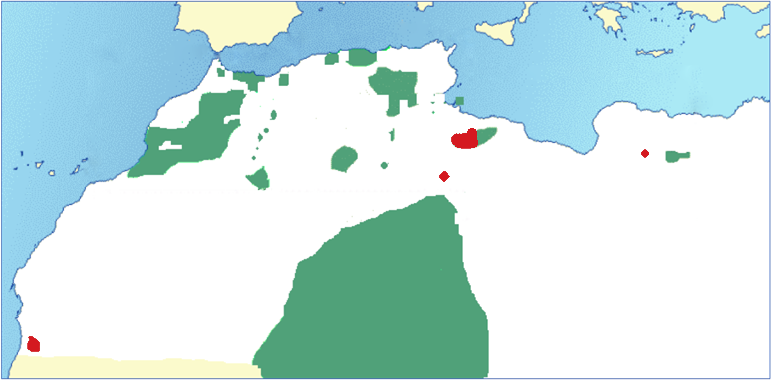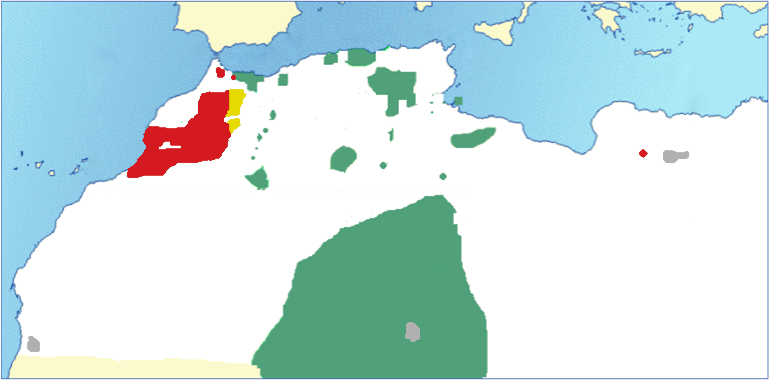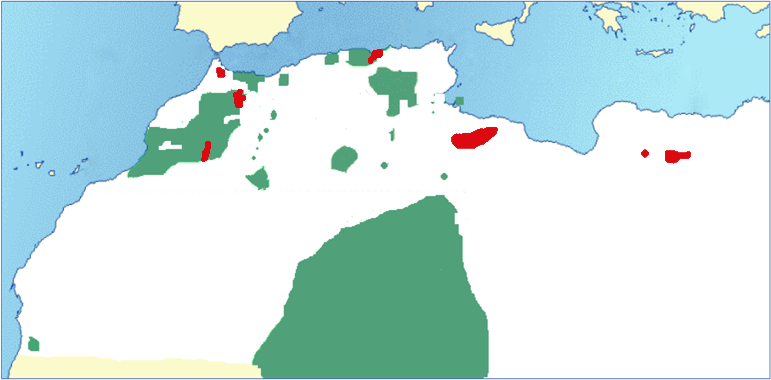
Now what about scattered variables? Some of them look very old and thus kind of put our basic ideas of continuity and large-group classifications in question.
Let’s take a look at a couple of them and shiver at their non-consistency.
Let’s take a look at a couple of them and shiver at their non-consistency.
https://twitter.com/ait_kisou/status/1349003344208125953?s=20
(1) The 2SG subject marker on the verb.
GREEN: -d
YELLOW -t (possibly a development from -d)
ReRED: -ḍ / -ṭ
There is no regular phonetic correspondence of -d to -ḍ.
GREEN: -d
YELLOW -t (possibly a development from -d)
ReRED: -ḍ / -ṭ
There is no regular phonetic correspondence of -d to -ḍ.

(2) In most varieties *β became (or remained?) /b/ in pre-consonantal position (GREEN). In a number of varieties, this didn’t happen (RED). 

(3) The Imperative M:PL suffix is -at in western Morocco AND in Awjila (Libya) (RED). It is -ət / -ăt elsewhere (GREEN). The yellow part has different suffixes. 

(4) The pharyngealized (“emphatic”) non-geminated alveolar is [dˁ] (or [ðˁ]) in most of Amazigh (GREEN), but in a scattered number of varieties, it is [tˁ] (RED). 

So what are we going to do about these scattered attestations?
One of the strange things in Amazigh is that its varieties are quite similar to each other. Amazigh languages vary in the way Germanic languages do, or Romance. This suggests a rather late spread.
One of the strange things in Amazigh is that its varieties are quite similar to each other. Amazigh languages vary in the way Germanic languages do, or Romance. This suggests a rather late spread.
But there is no good reason why such a spread should have taken place. No big-time archeaological records of migrations, no long-lived Amazigh empires…
One way to get around it has been suggested by Carles Múrcia. In early Antiquity, Amazigh may have been more diverse than it is now. Due to koineization (extreme convergence) somewhere in Antiquity, most of this diversity would have been lost.
diposit.ub.edu/dspace/handle/…
diposit.ub.edu/dspace/handle/…
Groupings like the Central group would attest to splits following this koineization. The scattered isoglosses may very well be remnants of pre-koine variation (my interpretation, not necessarily that of Carles).
I will end this thread with an isogloss that may be related to the koine. The first one is the word for “cow”, which is /tafunast/ (GREEN) almost everywhere, except for some regions which still have the ancient Afroasiatic /tast/ (etc.) (RED; YELLOW only in he plural). 

aseggwas nwem n jjdid d amimun!!!
NB. While all the outrageous things in this thread are mine, most of the good stuff was found out by others, ranging from colonial works like those by Edmond Destaing and modern work by brilliant scholars such as @lameensouag and @Phdnix.
NB. While all the outrageous things in this thread are mine, most of the good stuff was found out by others, ranging from colonial works like those by Edmond Destaing and modern work by brilliant scholars such as @lameensouag and @Phdnix.
• • •
Missing some Tweet in this thread? You can try to
force a refresh


